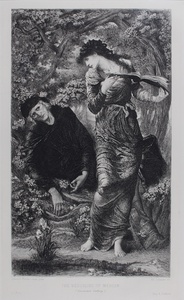| Method | Etching |
| Artist | Adolph Lalauze after Sir Edward Coley Burne-Jones |
| Published | Imp. A. Salmon. [1877] |
| Dimensions | Image 255 x 150 mm, Plate 285 x 170 mm, Sheet 445 x 305 mm |
| Notes |
Page 80 from Volume X of L'Art (1877). Inscription beneath image reads: The Beguiling of Merlin (Grosvenor Gallery). A depiction of Merlin lying helpless in a hawthorn bush whilst Nimue, on the right, reads from a book and beguiles him with enchantment. The etching is after the Burne-Jones oil painting of the same name, now in the Lady Lever Art Gallery, Liverpool. The writer Oscar Wilde described the work as being 'full of magic'. Adolphe Lalauze (1838 - 1906) was a French nineteenth century etcher and illustrator. He first gained employment as a recording controller and then studied art in Paris under Gaucherel. Early on he concentrated upon original etching, with many of his works commissioned by Cadart in Paris. Lalauze specialised in figure and genre scenes, particularly those depicting women and children. Around 1880, Lalauze gained recognition as a fine illustrative artist. He illustrated such works as Paul et Virginie, Physiologie de gout, La Diable amoureux, Don Quichotte, The Vicar of Wakefield, Manon Lescaut and Gulliver's Travels. Lalauze first exhibited at the Paris Salon in 1872. He received medals from the Exposition Universale in 1876, 1878 and 1889 and was awarded the Chevalier de la Legion d'honneur from the French government. He was also the father of the painter, Alphonse Lalauze, and the etching teacher of Felix Buhot. Sir Edward Coley Burne-Jones, 1st Bt (1833-1898) was a painter and designer closely associated with the later phase of the Pre-Raphaelite movement. Burne-Jones met William Morris as an undergraduate of Exeter College, Oxford, whilst studying for a degree in theology. The pair went on to work very closely together on numerous decorative arts projects including stained glass windows, tapestries, and illustrations. Originally intending to become a church minister, Burne-Jones never finished his degree, choosing instead to pursue an artistic career under the influence of Dante Gabriel Rossetti. Rossetti heavily inspired his early work, but by the 1860's his idiosyncratic style was beginning to develop. His mature work, however different in total effect, is rich in conscious echoes of Botticelli, Mantegna and other Italian masters of the Quattrocento. Thusly, Burne Jones' later paintings of classical and medieval subjects are some of the most iconic of the Pre-Raphaelite movement. He was at the height of his popularity during the 1880's, though his reputation began to decline with the onset of the Impressionists. He was created a baronet in 1894, when he formally hyphenated his name. Alfred Salmon was a copper-plate printer active c.1863 - 1894. Born in 1825, he was trained by Chardonaîné at Rue Hautefeuille. He set up on his own when he took over Rémond's business in 1863. Between 1890 and 1894 he was in partnership with Adolphe Ardail (1835-1911), trading as Salmon & Ardail. In 1894 the premises at 187 Rue St Jacques were taken over by Salmon's son-in-law, and in 1895 by his grandson Alfred Louis Porcabeuf (b.1867). |
| Framing | mounted |
| Price | £400.00 |
| Stock ID | 45467 |

